Vibration Energy Conversion Power Supply Based on the Piezoelectric Thin Film Planar Array
Abstract
:1. Introduction
2. Energy Conversion Principle and Circuit Model of Vibration Energy Harvester
3. Design and Test of Piezoelectric Vibration Energy Conversion Power Supply Scheme
3.1. Fabrication and Testing of a Vibration Energy Harvester Based on a PVDF Piezoelectric Thin Film
3.2. Improved Design of the Vibration Energy Conversion Power Supply Using a Multiple Piezo-Film Structure
3.3. Fabrication and Experimental Testing of the Vibration Energy Conversion Power Supply Using a Multiple Piezo Film Structure
4. Conclusions
Author Contributions
Funding
Institutional Review Board Statement
Informed Consent Statement
Data Availability Statement
Conflicts of Interest
References
- Shirvanimoghaddam, M.; Abolhasani, M.M.; Farhangi, M.; Barsari, V.Z.; Liu, H.; Dohler, M.; Naebe, M. Towards a Green and Self-Powered Internet of Things Using Piezoelectric Energy Harvesting. IEEE Access 2019, 7, 94533–94556. [Google Scholar] [CrossRef]
- Wang, Z.L. Self-Powered Nanosensors and Nanosystems. Adv. Mater. 2012, 24, 280–285. [Google Scholar] [CrossRef]
- Prauzek, M.; Konecny, J.; Borova, M.; Janosova, K.; Hlavica, J.; Musilek, P. Energy Harvesting Sources, Storage Devices and System Topologies for Environmental Wireless Sensor Networks: A Review. Sensors 2018, 18, 2446. [Google Scholar] [CrossRef] [Green Version]
- De Oliveira, M.A.; Monteiro, A.V.; Filho, J.V. A New Structural Health Monitoring Strategy Based on PZT Sensors and Convolutional Neural Network. Sensors 2018, 18, 2955. [Google Scholar] [CrossRef] [Green Version]
- Shuai, Q.; Zhou, K.; Zhou, S.; Tang, J. Fault identification using piezoelectric impedance measurement and model-based intelligent inference with pre-screening. Smart Mater. Struct. 2017, 26, 045007. [Google Scholar] [CrossRef]
- Katunin, A.; Dragan, K.; Dziendzikowski, M. Damage identification in aircraft composite structures: A case study using various non-destructive testing techniques. Compos. Struct. 2015, 127, 1–9. [Google Scholar] [CrossRef]
- Zhang, Y.; Wang, Z.J.; Jiang, S.L.; Wang, Q. Retrospectives and Perspectives of Vibration Energy Harvest Technologies. Mech. Sci. Technol. Aerosp. Eng. 2019, 38, 985–1018. [Google Scholar]
- Kuo, C.-L.; Lin, S.-C.; Wu, W.-J. Fabrication and performance evaluation of a metal-based bimorph piezoelectric MEMS generator for vibration energy harvesting. Smart Mater. Struct. 2016, 25, 105016. [Google Scholar] [CrossRef]
- Tian, Y.; Li, G.; Yi, Z.; Liu, J.; Yang, B. A low-frequency MEMS piezoelectric energy harvester with a rectangular hole based on bulk PZT film. J. Phys. Chem. Solids 2018, 117, 21–27. [Google Scholar] [CrossRef]
- Qi, S.; Oudich, M.; Li, Y.; Assouar, B. Acoustic energy harvesting based on a planar acoustic metamaterial. Appl. Phys. Lett. 2016, 108, 263501. [Google Scholar] [CrossRef]
- Lee, G.; Lee, D.; Park, J.; Jang, Y.; Kim, M.; Rho, J. Piezoelectric energy harvesting using mechanical metamaterials and phononic crystals. Commun. Phys. 2022, 5, 94. [Google Scholar] [CrossRef]
- Wankhade, S.H.; Tiwari, S.; Gaur, A.; Maiti, P. PVDF–PZT nanohybrid based nanogenerator for energy harvesting applications. Energy Rep. 2020, 6, 358–364. [Google Scholar] [CrossRef]
- Mohanty, A.; Parida, S.; Behera, R.K.; Roy, T. Vibration energy harvesting: A review. J. Adv. Dielectr. 2019, 9, 1930001. [Google Scholar] [CrossRef]
- Ning, Y.W.; Zhang, J.T.; Zhang, J. Optimal Design of Cantilever PVDF Piezoelectric Wind Energy Generator. Small Spec. Electr. Mach. 2020, 48, 1–5. (In Chinese) [Google Scholar]
- Tsukamoto, T.; Umino, Y.; Shiomi, S.; Yamada, K.; Suzuki, T. Bimorph vibration energy harvester with flexible 3D mesh structure. Sci. Technol. Adv. Mater. 2018, 19, 660–668. [Google Scholar] [CrossRef] [Green Version]
- Min, N.K.; Kwon, K.H. Micromachining of a bimorph Pb(Zr,Ti) O3 (PZT) cantilever using a micro-electromechanical systems (MEMS) process for energy harvesting application. J. Nanosci. Nanotechnol. 2012, 12, 6011–6015. [Google Scholar] [CrossRef]
- Vijaya, M.S. Piezoelectric materials, Piezoelectric characteristics. In Piezoelectric Materials and Devices: Applications in Engineering and Medical Sciences, 1st ed., 2nd ed.; CRC Press: Boca Raton, FL, USA, 2013; pp. 6–9; pp. 15–21. [Google Scholar]
- Wang, D.S.; Akdogan, E.K. Piezoelectric Materials and piezoelectric effect, Structural Design and Development of Flextensional Piezoelectric Transducer. In Design Principle for Piezoelectric Transducer, 1st ed., 4th ed.; Wuhan University of Technology Press: Wuhan, China, 2016; pp. 16–36; pp. 76–82. [Google Scholar]
- Bowen, C.R.; Kim, H.A.; Weaver, P.M.; Dunn, S. Piezoelectric and ferroelectric materials and structures for energy harvesting applications. Energy Environ. Sci. 2014, 7, 25–44. [Google Scholar] [CrossRef] [Green Version]
- Noël, E.D.; Wardle, B.L.; Kim, S.G. Design considerations for mems-scale piezoelectric mechanical vibration energy harvesters. Integr. Ferroelectr. 2006, 71, 121–160. [Google Scholar]
- Roundy, S.; Wright, P.K. A piezoelectric vibration based generator for wireless electronics. Smart Mater. Struct. 2004, 13, 1131–1142. [Google Scholar] [CrossRef] [Green Version]
- Priya, S.; Inman, D.J. Electromechanical Model of Vibration Energy Harvester Using Piezoelectric Cantilever. In Energy Harvesting Technologies, 2nd ed.; Springer Science: Heidelberg/Berlin, Germany, 2010; pp. 36–55. [Google Scholar]
- Ottman, G.; Hofmann, H.; Bhatt, A.; Lesieutre, G. Adaptive piezoelectric energy harvesting circuit for wireless remote power supply. IEEE Trans. Power Electron. 2002, 17, 669–676. [Google Scholar] [CrossRef] [Green Version]
- Sukumaran, S.; Chatbouri, S.; Rouxel, D.; Tisserand, E.; Thiebaud, F.; Ben Zineb, T. Recent advances in flexible PVDF based piezoelectric polymer devices for energy harvesting applications. J. Intell. Mater. Syst. Struct. 2021, 32, 746–780. [Google Scholar] [CrossRef]
- Dickinson, D. Piezoelectric Energy Harvesting Power Supply; Analog Devices (ADI): Milpitas, CA, USA, 2010; Available online: https://www.analog.com/en/about-adi/news-room/press-releases/2010/piezoelectric-energy-harvesting-power-supply.html (accessed on 7 January 2010).
- Saxena, P.; Shukla, P. A comprehensive review on fundamental properties and applications of poly(vinylidene fluoride) (PVDF). Adv. Compos. Hybrid Mater. 2021, 4, 8–26. [Google Scholar] [CrossRef]
- Zhang, H.; Heng, T.T.; Fang, Z.G.; Hu, X.; Fang, L.; Lu, C.H. High-energy-density ceramic/PVDF-based nanocomposites dielectrics. Acta Mater. Compos. Sin. 2021, 28, 2114–2128. [Google Scholar]
- Robert, X.G.; Cui, Y. Vibration-based energy extraction for sensor powering: Design, analysis, and experimental evaluation. In Smart Structures and Materials 2005: Sensors and Smart Structures Technologies for Civil, Mechanical, and Aerospace Systems; SPIE: Bellingham, DC, USA, 2005; Volume 5765. [Google Scholar]




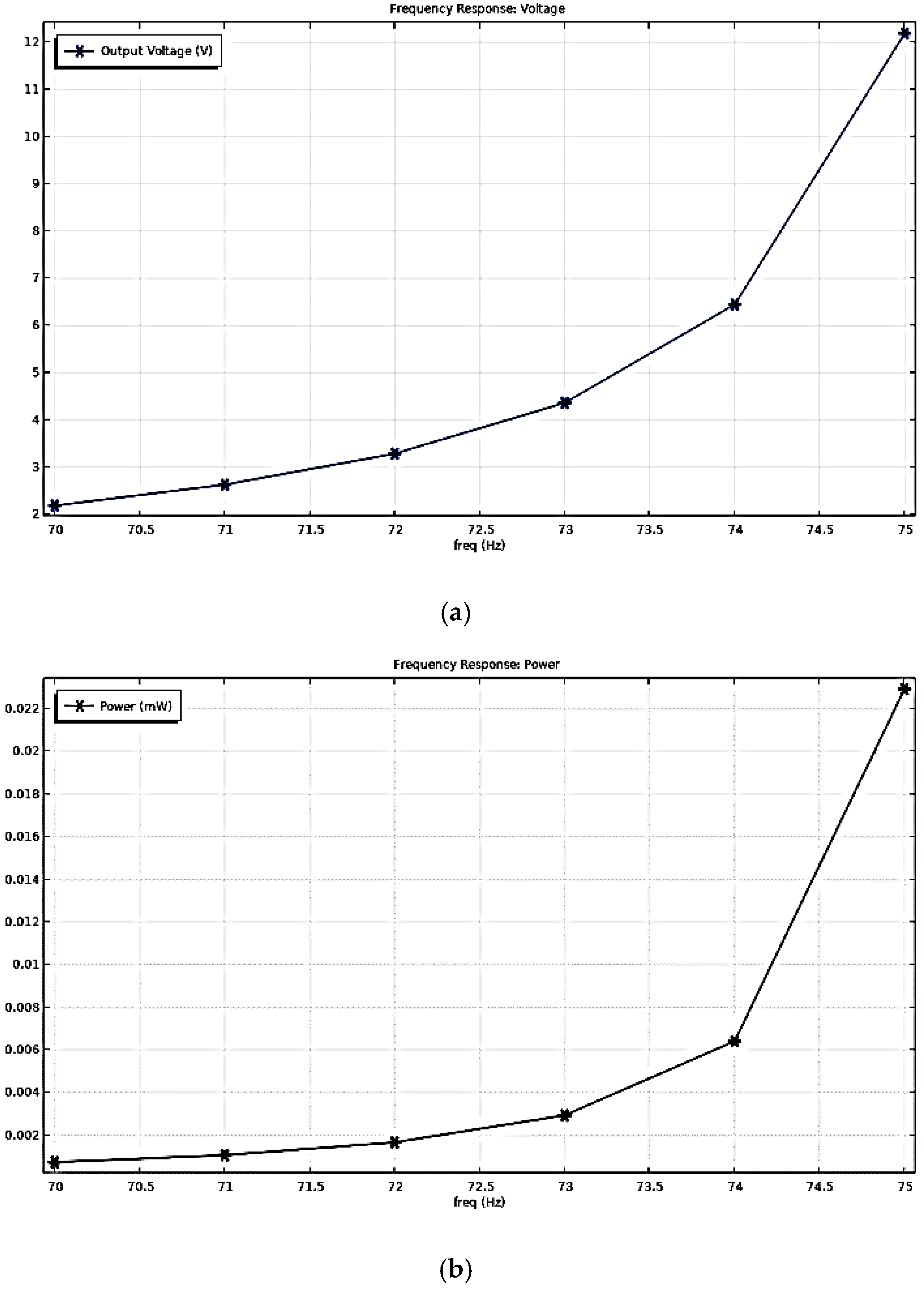
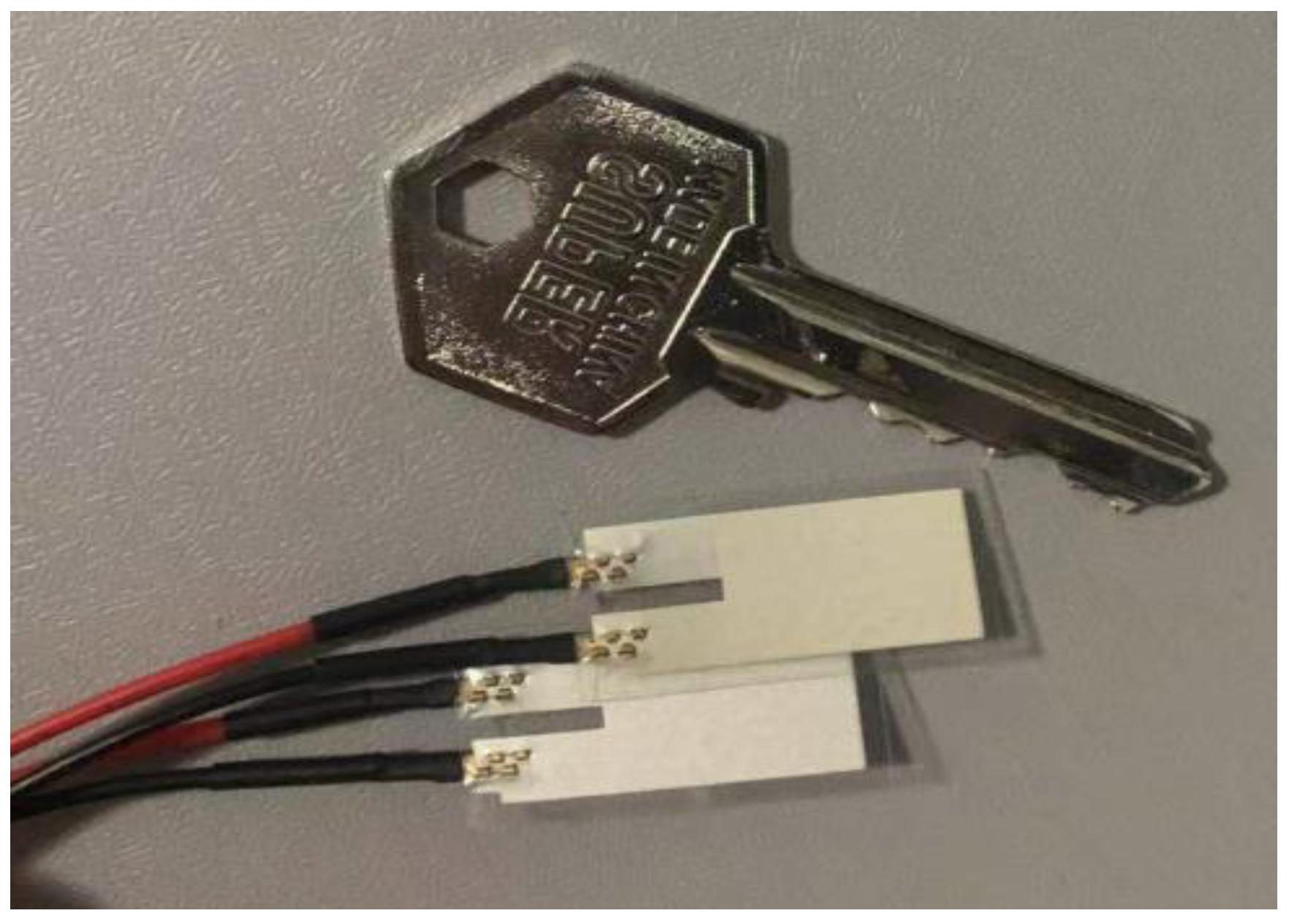


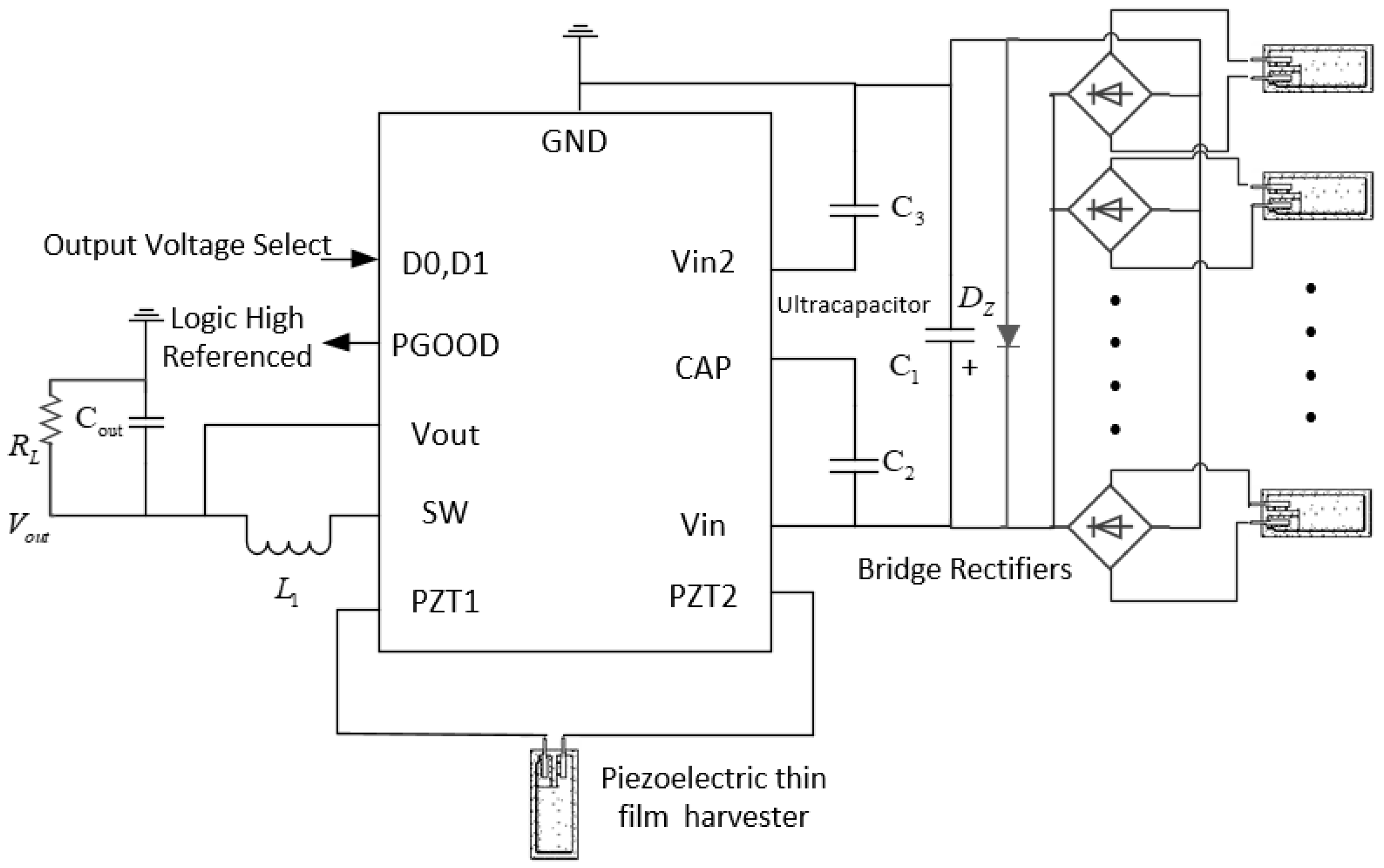

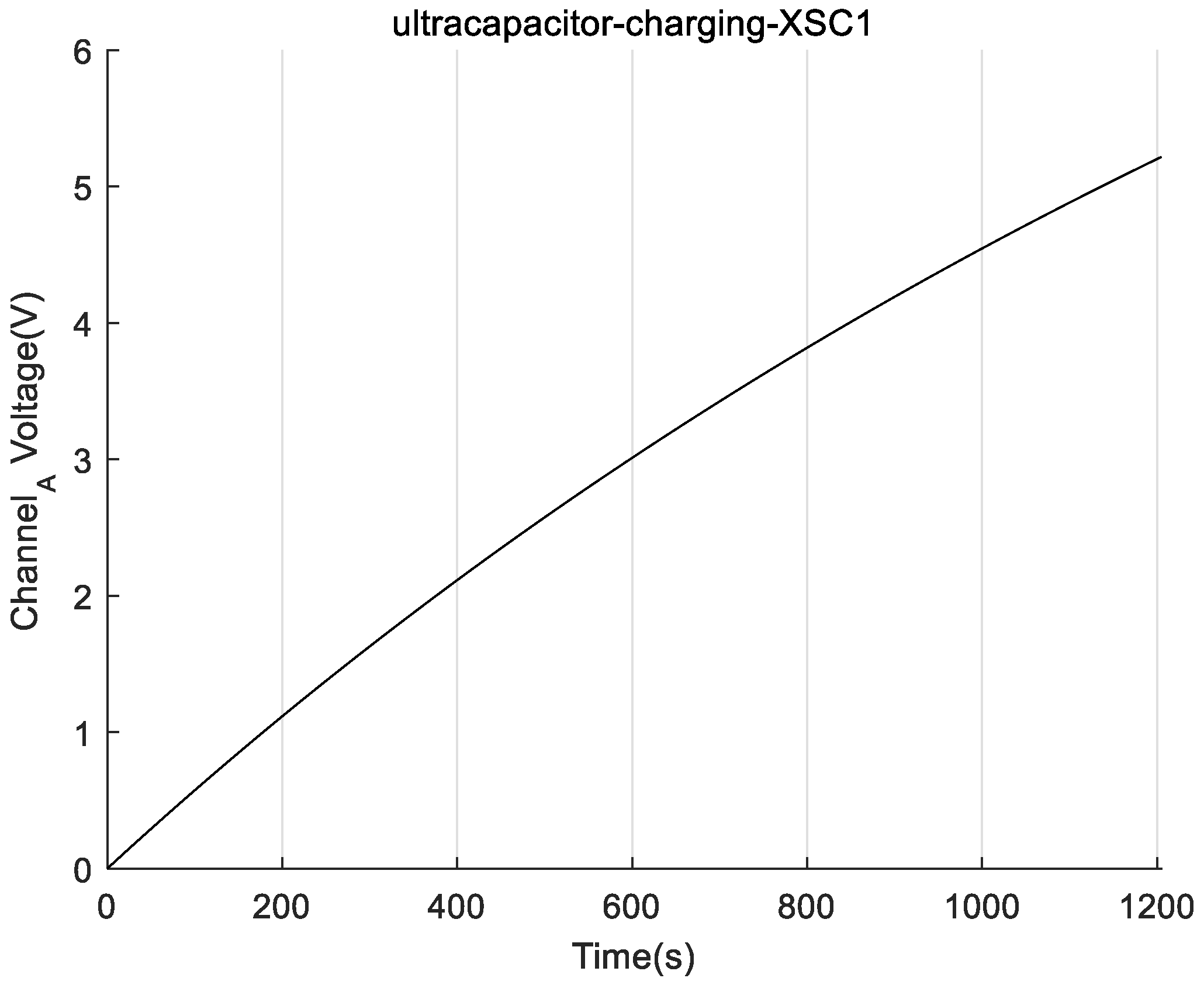
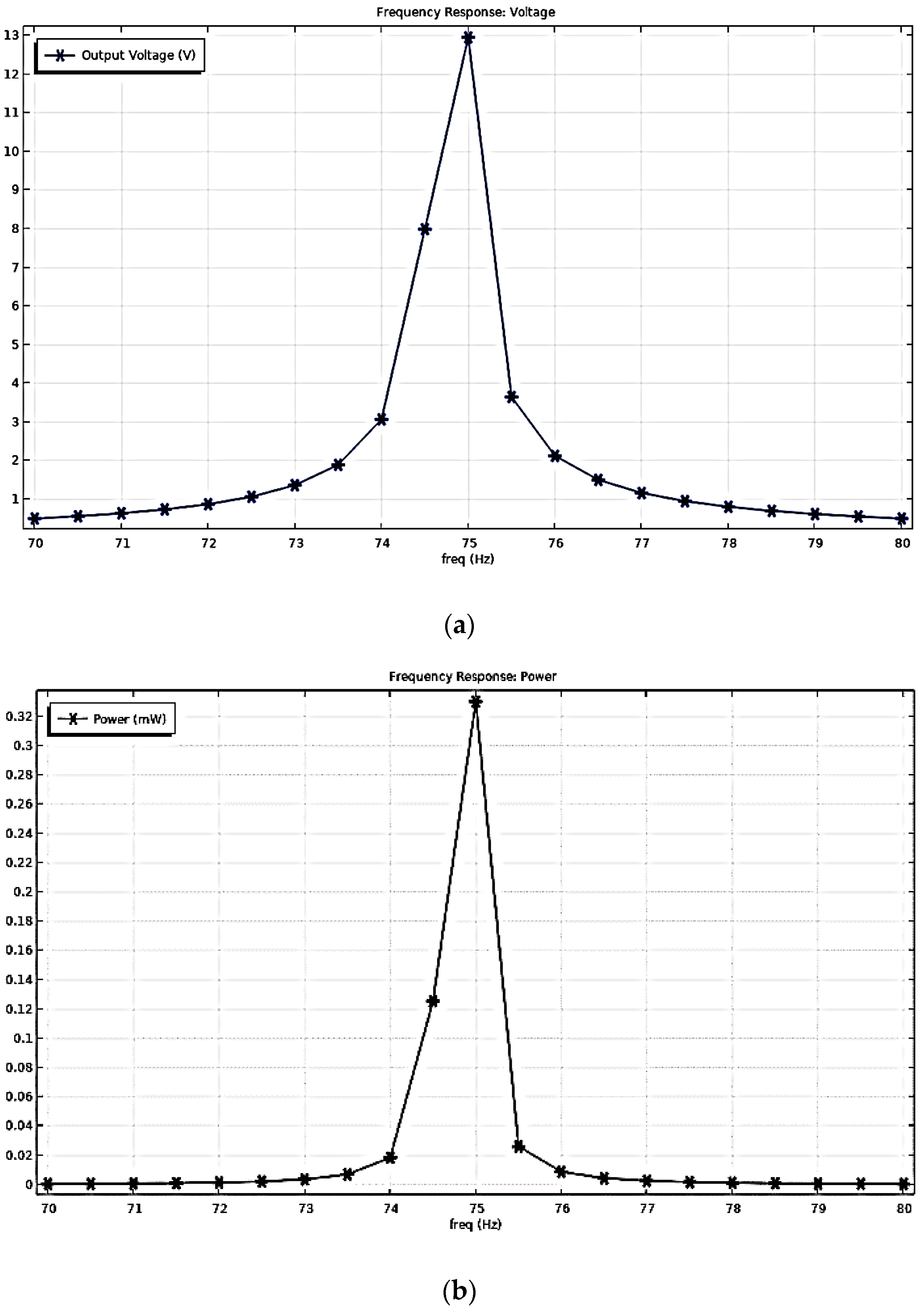
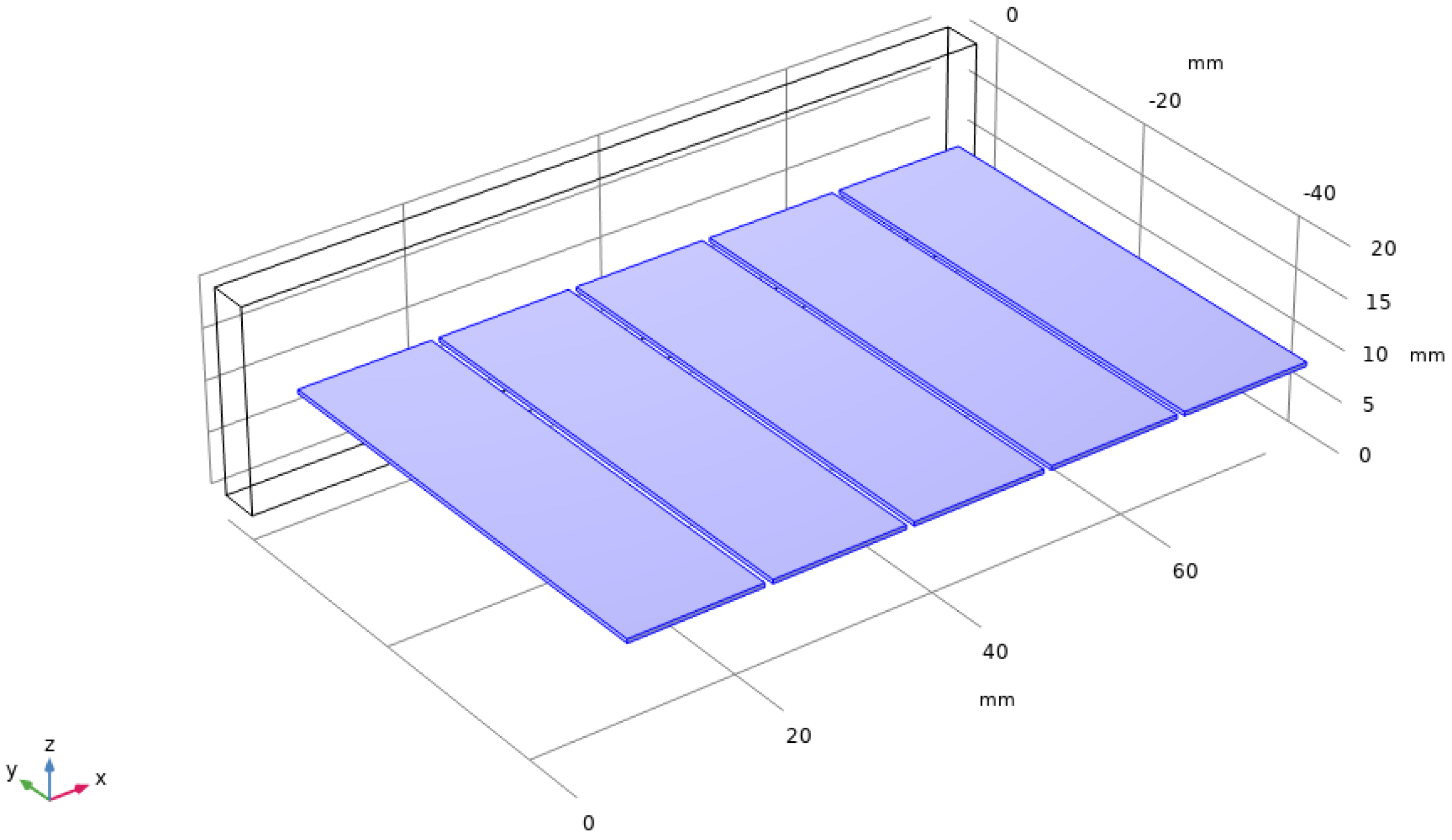
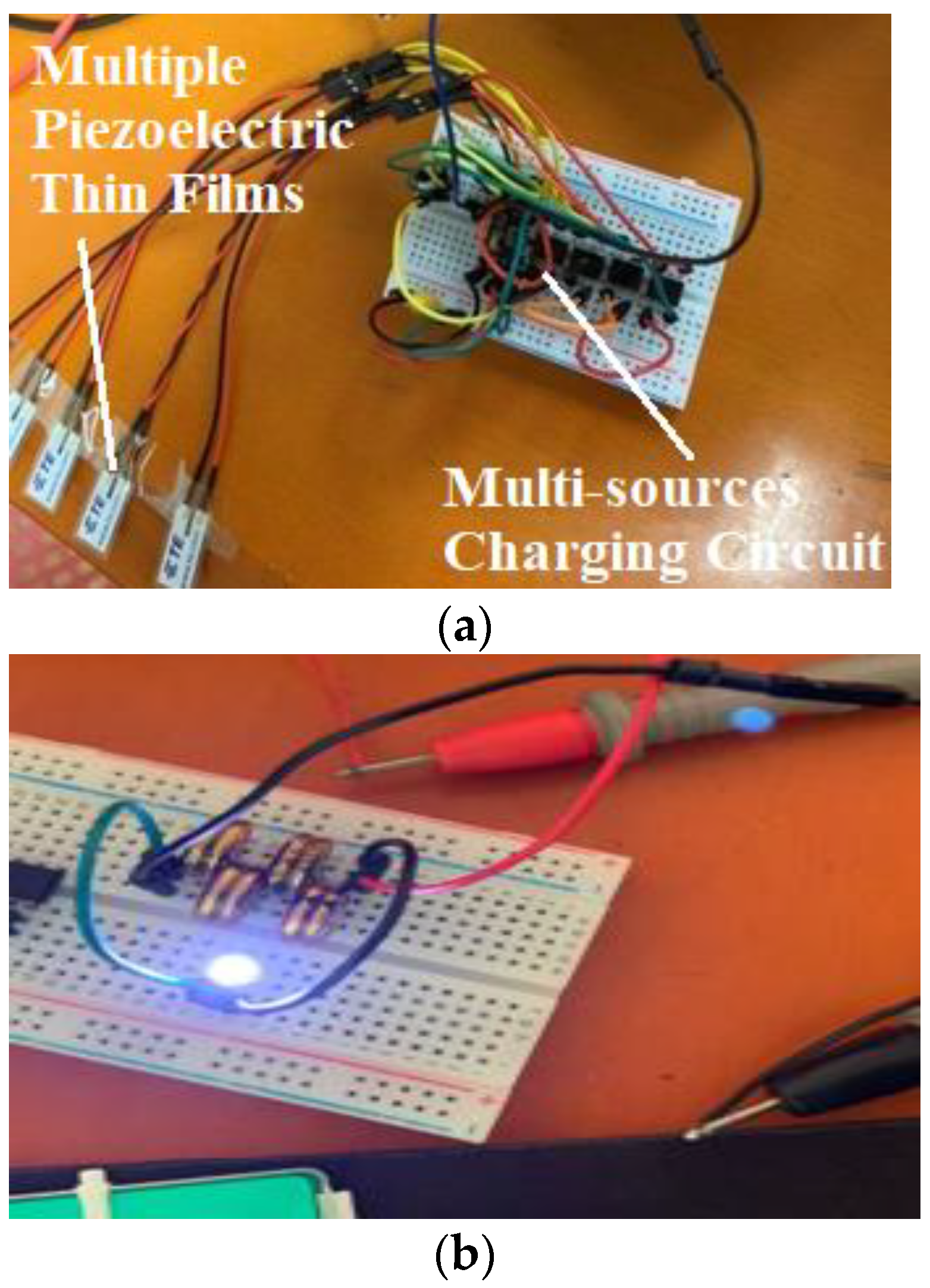
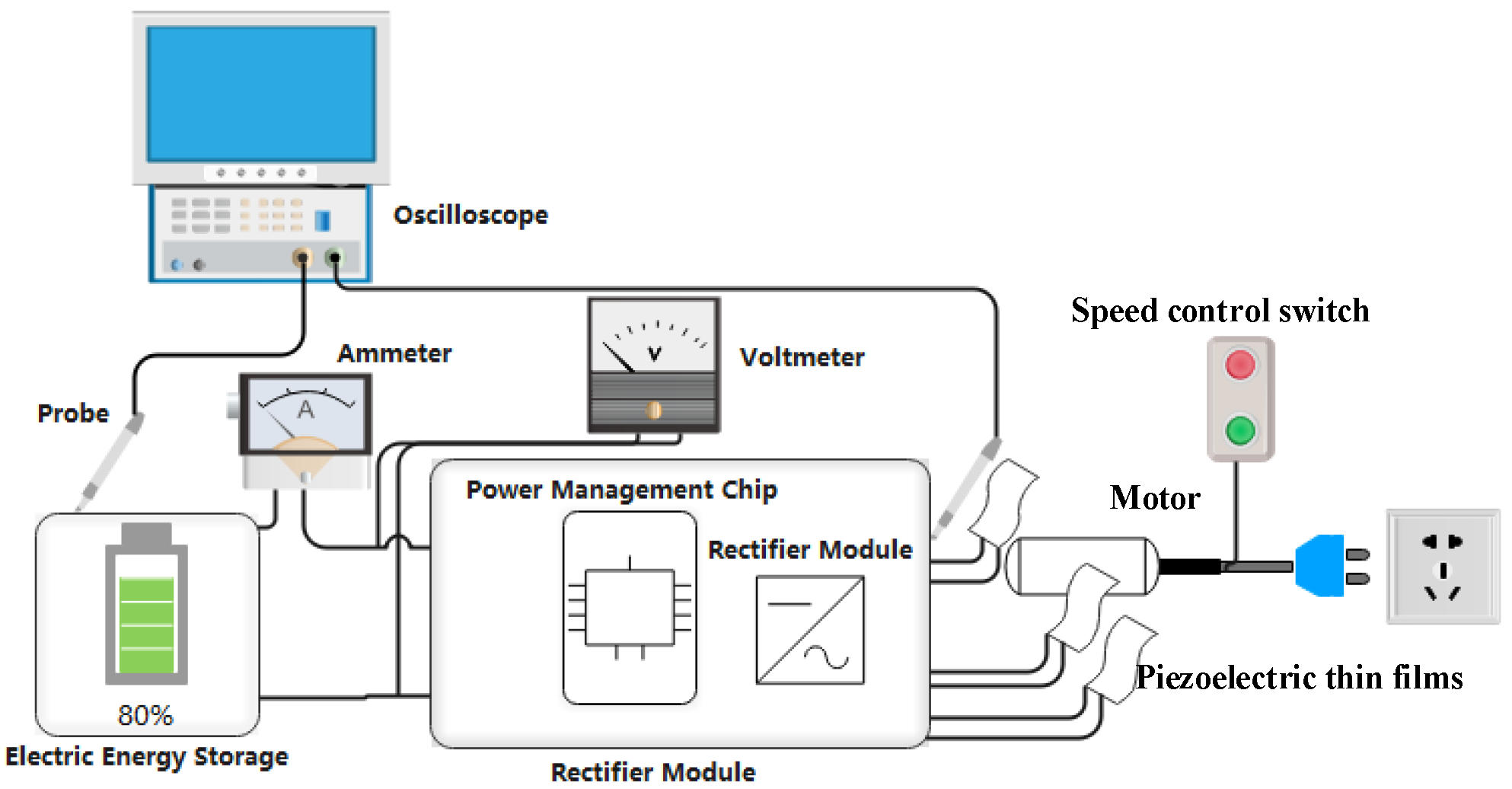

| Model | PVDF | PZT | MFC | |
|---|---|---|---|---|
| Parameter | ||||
| Density/kg·m−3 | 1780 | 7500 | 5440 | |
| Poisson’s ratio | 0.3 | 0.36 | 0.312 | |
| Young’s modulus/GPa | 2.5 | 76.5 | 5.52 | |
| Piezoelectric charge coefficient d33/pC·N−1 | 33 | 640 | 467 | |
| Coupling factor k33 | 0.14 | 0.76 | 0.339 | |
| Piezoelectric voltage constants g33/Vm·N−1 | 0.34 | 0.02 | 0.275 | |
| Relative permittivity Ɛr3T | 13.2 | 3400 | 1700 | |
| Dielectric loss tanδ% | 8.9 | 1.8 | 2 | |
| Volume resistivity /Ω·m−1 | 10 × 1015 | 10 × 1011 | 10 × 1013 | |
| Mechanical durability/times | 2 × 1011 | 3.5 × 108 | 1.0 × 1010 | |
| Curie point Tc/°C | 170 | 300 | 176 | |
| N | ||||
|---|---|---|---|---|
| 1 | 39.22 | 11.44 | 35.64 | 138.40 |
| 2 | 78.10 | 24.46 | 19.84 | 69.30 |
| 3 | 113.53 | 34.12 | 15.74 | 42.50 |
| 4 | 155.14 | 46.62 | 12.34 | 33.50 |
| 5 | 193.17 | 58.23 | 11.16 | 19.87 |
| N | ||
|---|---|---|
| 1 | 12.671 | 0.023 |
| 2 | 12.732 | 0.058 |
| 3 | 12.772 | 0.137 |
| 4 | 12.827 | 0.226 |
| 5 | 12.962 | 0.339 |
Publisher’s Note: MDPI stays neutral with regard to jurisdictional claims in published maps and institutional affiliations. |
© 2022 by the authors. Licensee MDPI, Basel, Switzerland. This article is an open access article distributed under the terms and conditions of the Creative Commons Attribution (CC BY) license (https://creativecommons.org/licenses/by/4.0/).
Share and Cite
Wang, B.; Lan, D.; Zeng, F.; Li, W. Vibration Energy Conversion Power Supply Based on the Piezoelectric Thin Film Planar Array. Sensors 2022, 22, 8506. https://doi.org/10.3390/s22218506
Wang B, Lan D, Zeng F, Li W. Vibration Energy Conversion Power Supply Based on the Piezoelectric Thin Film Planar Array. Sensors. 2022; 22(21):8506. https://doi.org/10.3390/s22218506
Chicago/Turabian StyleWang, Bo, Dun Lan, Fanyang Zeng, and Wei Li. 2022. "Vibration Energy Conversion Power Supply Based on the Piezoelectric Thin Film Planar Array" Sensors 22, no. 21: 8506. https://doi.org/10.3390/s22218506




